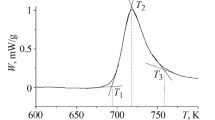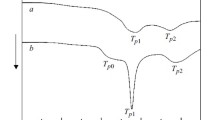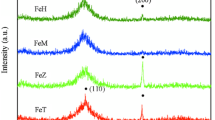Abstract
Fe-Tm-B base (TM=transition metal) amorphous alloys (metallic glasses) are thermodynamically metastable. This limits their use as otherwise favourable materials, e.g. magnetically soft, corrosion resistant and mechanically firm. By analogy of the mechanical strain-stress dependence, at a certain degree of thermal activation the amorphous structure reaches its limiting state where it changes its character and physical properties. Relaxation and early crystallization processes in amorphous alloys, starting already around 100°C, are reviewed involving subsequently stress relief, free volume shrinking, topological and chemical ordering, pre-crystallization phenomena up to partial (primary) crystallization. Two diametrically different examples are demonstrated from among the soft magnetic materials: relaxation and early crystallization processes in the Fe-Co-B metallic glasses and controlled crystallization of amorphous ribbons yielding rather modern nanocrystalline “Finemet” alloys where late relaxation and pre-crystallization phenomena overlap when forming extremely dispersive and fine-grained nanocrystals-in-amorphous-sauce structure. Mössbauer spectroscopy seems to be unique for magnetic and phase analysis of such complicated systems.
Similar content being viewed by others
References
B. Cantor, Devitrification of amorphous alloys, in:Proc. 3rd Int. Conf. Amorphous Metallic Materials, AMM III, Topolcianky 1992 (Trans. Tech. Publ., Zurich) p. 2.
S. Foner, J. Appl. Phys. 38 (1967) 1510.
V. Veselý, T. Zemčík, in:Proc. Int. Conf. Applications Mössbauer Effect, ICAME'89, Budapest 1989, Hyp. Int. 55–58 (1990) 2679.
E. Illeková, A generalized model of structural relaxation in metallic and chalcogenide glasses, in:Proc. 3rd Int. Conf. Amorphous Metallic Materials, AMM III, Topolcianky 1992 (Trans. Tech. Publ., Zurich) p. 54.
I. Turek and T. Zemčík, Hyp. Int. 55 (1990) 1089.
I. Turek, in:Proc. 2nd Int. Conf. Amorphous Metallic Materials, AMM II, Smolenice 1989, (Trans. Tech. Publ., Zurich, 1990) p. 293.
T. Zemčík, in:Proc. Int. Conf. Applications Mössbauer Effect, ICAME'89, Budapest 1989, Hyp. Int. 55–58 (1990) 1099.
B. Million, Kovové materiály (Metallic Materials) 1 (1967) 33.
T. Zemčík, K. Závěta, L. Kraus and V.D. Sedykh, Proceedings of this conference, Hyp. Int. 83 (1994) 275.
J.M. Dubois and G. Le Caer, Nucl. Instr. Meth. 199 (1982) 307.
J.I. Budnick, F.H. Sanchez, Y.D. Zhang, M. Choi, W.A. Hines, Z.Y. Zhang, S.H. Ge and R. Hasegawa, IEEE Trans. Magn. MAG-23 (1987) 1937.
H.-G. Wagner, M. Ackermann, R. Gaa and U. Gonser, in:Rapidly Quenched Metals, eds. S. Steeb and H. Warlimont (North-Holland, Amsterdam, 1985) p. 247.
J. Pavlovský and T. Zemcík, Phys. Stat. Sol. (a) 112 (1989) K1.
T. Zemčík and S. Havlíček, in:Proc. Conf. Hyperfine Interactions, HFI'89, Prague 1989, Hyp. Int. 59 (1990) 465.
T. Zemčík and S. Havlíček, in:Proc. Int. Conf. Applications Mössbauer Effect, ICAME'89, Budapest 1989, Hyp. Int. 55–58 (1990) 1103.
P. Duhaj and P. Svec, in:Proc. 2nd Int. Conf. Amorphous Metallic Materials, AMM II, Smolenice 1989 (Trans. Tech. Publ., Zurich, 1990) p. 69.
Y. Yoshizawa and K. Yamauchi, IEEE Trans. Magn. 25 (1989) 3324.
G. Herzer, IEEE Trans. Magn. MAG-25 (1989) 3327.
M. Fujinami, Y. Hashiguchi and T. Yamamoto, Japan J. Appl. Phys. 29 (1990) L477.
O. Kohmoto, K. Haneda and T. Choh, Japan J. Appl. Phys. 29 (1990) L1460.
T. Zemčík, Y. Jirásková, K. Závěta, D. Eckert, J. Schneider, N. Mattern and D. Hesske, Mater. Lett. 10 (1991) 313.
T. Zemčík, Phase analysis of amorphous and nanocrystalline FeCuNbSiB alloys by57Fe Mössbauer spectroscopy, in:Proc. 3rd Int. Conf. Amorphous Metallic Materials, AMM III, Topolcianky 1992 (Trans. Tech. Publ., Zurich) p. 261.
T. Zemčík, Y. Jirásková and M. Kočová, J. Mater. Sci. Lett. 12 (1992) 1298.
G. Hampel, A. Pundt and J. Hesse, J. Phys.: Condens. Matter 4 (1992) 3195.
A. Pundt, G. Hampel and J. Hesse, Z. Phys. B 87 (1992) 65.
M. Knobel, R. Sato Turtelli and H.R. Rechenberg, J. Appl. Phys. 71 (1992) 6008.
J. Ryba, T. Zemčík, Anomalous increase of the saturation magnetic polarization during structural relaxation of amorphous Fe73.5Cu1Nb3Si13.5B9, in:Proc. 3rd Int. Conf. Amorphous Metallic Materials, AMM III, Topolcianky 1992 (Trans. Tech. Publ., Zurich) p. 583.
T. Zemčík and J. Ryba, Proceedings of this conference, Hyp. Int. 83 (1994) 299.
Author information
Authors and Affiliations
Rights and permissions
About this article
Cite this article
Zemčík, T. Stability of (Fe-Tm-B) amorphous alloys: relaxation and crystallization phenomena. Hyperfine Interact 83, 131–145 (1994). https://doi.org/10.1007/BF02074265
Issue Date:
DOI: https://doi.org/10.1007/BF02074265




